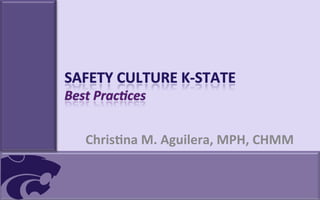
Safety culture _ Aguilera version
- 1. Chris&na M. Aguilera, MPH, CHMM
- 2. Steps to Safety The product of individual and group values, a7tudes, percep8ons, competencies and pa:erns of behavior …. Reflects the a*tudes, beliefs, percep4ons and values shared related to safety. affect behavioral norms
- 3. Steps to Safety • How is work performed independent of policies and wri:en documents.
- 4. Steps to Safety • Make safety the campus norm • Self enforcing community Safety Climate Safety Goal
- 5. Culture Values A7tudes Percep8ons Competencies Behaviors
- 6. Steps to Safety • Engrained and takes 8me to alter • Not just mission statements • Ac8ons, prac8ces, norms and perspec8ves of the people of an organiza8on from the top to the bo:om.
- 7. Steps to Safety • Safety recognized as part of the work process that supports the ins8tu8onal product of learning, research, and community involvement.
- 9. Steps to Safety • Organiza&onal Culture – Management commitment – Community Norms • Training and outreach – Understand hazards/risks and controls – Impetus • Reinforcement
- 10. Steps to Safety • Percep8ons of Risk • Priori8es – aligned with safety goals • Policies – how safety is integrated?
- 11. Steps to Safety • Individuals need to believe: – There is a risk • They are vulnerable to injury/exposure/illness – Recommended controls work and are reasonable – They are supported in their safety ac8ons • By their peers (norm) • By their supervisor • Group level dynamics play a role – They are valued
- 12. Steps to Safety • Building ins8tu8onal commitment – Produc8on priority separate from safety priority – Lack of informa8on – accountability – Lack of funding to correct unsafe condi8ons • Lack of hazard iden8fica8on and risk assessment – Lack of a lessons learned process • Limited training mechanisms • Lack of ac8on to correct unsafe behaviors • Lack of employee involvement or buy-‐in – Some8mes a poor pre-‐established culture
- 14. Steps to Safety • No one approach is completely successful • Business uses: – Enforcement – Training – Incen8ve (e.g., lack of injury, reduced insurance rate)
- 15. Steps to Safety • Seat Belts, – Engineering controls (audible alarm) – Ad campaign – Enforcement – All affected norms • Speeding, • Drunk Driving
- 17. Steps to Safety Assess Train Outreach Reinforce
- 18. Steps to Safety Assess Trust Train Outreach Reinforce
- 19. Steps to Safety • Job hazard analysis and… • Process reviews – Staff/Faculty use guides and check lists provided by EHS. • Control Banding – Establish standardized controls appropriate to the risk level – Helps ins8tu8onal safety commi:ees assess risks and assign controls when reviewing proposed work – Helps staff/researchers understand hazards and associated risks and quickly iden8fy controls
- 20. Steps to Safety Teaches how to: • Iden8fy hazards • Understand the risk and • Provides examples and tools for elimina8ng the hazard or controlling the risk
- 21. Steps to Safety • Raise safety awareness • Points campus community to resources • Iden8fies the expecta8ons for safety and shows the ins8tu8onal commitment Clear messages
- 22. Steps to Safety • Affect percep8ons and beliefs • Learns from marke8ng industry “selling safety” – Campaigns – Understanding the audience and what mo8vates them (different for different ages, cultures, etc.) – Telling stories – make it real to them • Creditable threat • Audience iden8fies with message – Effec8ve messages and communica8on tools (for target group) • Social media • Interac8ve training
- 23. Steps to Safety • Re-‐evaluate risk – Audits/inspec8ons – Change -‐ process change assessment • Success – difficult to quan8fy – Un-‐interrupted funding – Reduc8on of lost days – Lack of compliance findings (benchmark) – Strong reputa8on – safe campus – No bad press • Reinforce • Provide posi8ve feedback
- 24. Steps to Safety • Safety Awards or other incen8ves • Keep safety at the forefront (more marke8ng) – Safety review integrated into processes – Part of messages to patrons, prospec8ve students, • Performance evalua8ons/service credit – safety • Re-‐evaluate policies • Take ac8on
- 25. Steps to Safety • Clear • Approachable & trusted • Responsive • Ra8onale • Resource • Effec8ve • Strong rela8onships CARES
- 27. Steps to Safety • Value employees and students • Provide clear messages • Ensure students and staff – Understand how to iden8fy hazards, true risks and proper controls – Engaged – Situa8onal awareness – Provided with resources – “Sold” on safety
- 28. Steps to Safety • Define safety responsibili8es • Clear roles, procedures and policies – What, who, how (when, where) and why • Accountability, benchmarking • Repor8ng (incidents, near misses, injuries, symptoms, condi8ons, odors, etc.) – Follow up & follow through
- 29. Steps to Safety • Safety Commi:ee(s) • Proac8ve vs. reac8ve
- 30. Steps to Safety • Is part of the work, research, and learning processes – not seen as imposi8on or hindrance • Helps ensure safe produc8ve and uninterrupted working and learning environment
- 31. Thank you for your 8me!
